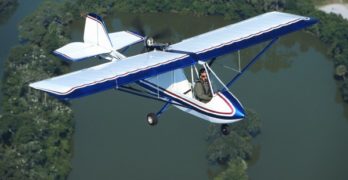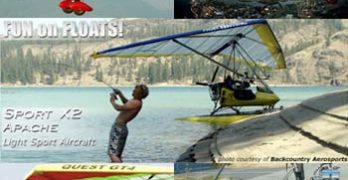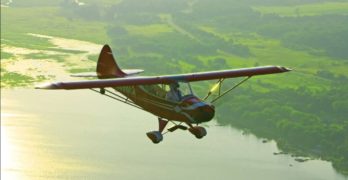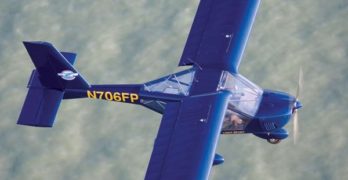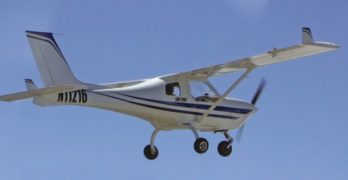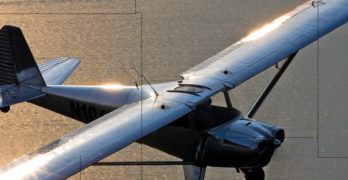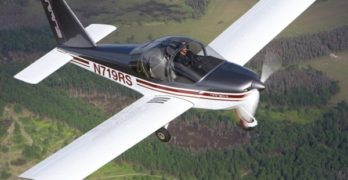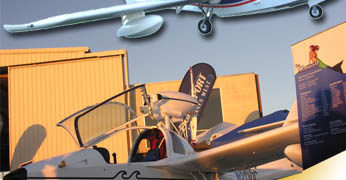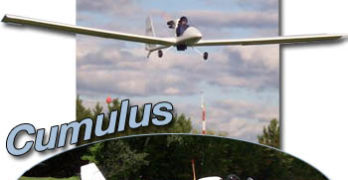“I started the company in 1983, and I still own it,” reports Dave Goulet, the main man behind the Challenger aircraft design and Quad City Ultralight Aircraft Corporation. “In fact,” he adds, “it’s probably the oldest ultralight company still under the same management. “After reviewing all the ultralight companies I can think of, I’m inclined to agree.”
Thinking of other long-term operations, Goulet mentions The New Kolb Aircraft Company, whose roots are also planted deep, but even that storied company has now changed ownership… twice in the last decade, and most recently just a couple years ago.
Quicksilver Mfg. has been around longer, but the revolving door of managers and several changes of ownership have long since taken that familiar brand out of contention for continuous leadership.
About the only challenge to Challenger’s continuity reign that I can think of would be Chuck Slusarczyk, designer of the Hawk series, and his company, CGS Aviation.
Search Results for : Flight Design
Not finding exactly what you expected? Try our advanced search option.
Select a manufacturer to go straight to all our content about that manufacturer.
Select an aircraft model to go straight to all our content about that model.
Think All Trikes Are Foreign? Think Again!
Weight-shift control LSA, affectionately referred to as “trikes,” are often made overseas. That’s a bit weird as the concept originated in the USA and spread around the globe. Tens of thousands are flying, despite their relative rarity in America. So you could be excused for viewing trikes as foreign. Not all of them… *** Though it won approval last summer, the newest SLSA in the game — we now have 89 models from 67 companies — is the North Wing Design Sport X2, available in two models plus ELSA versions with alternate engines. The Navajo may represent the least expensive SLSA you can purchase, retailing for $29,000 ready-to-fly. An Apache model is more dressed out and runs $32,000, still quite a bargain in today’s world of $135,000 SLSA airplanes. (More price info.) *** North Wing is an all-American company from Washington state making both trike carriage and wings.
Savage Cub-like Taildragger
As we near the fourth anniversary of the introduction
of the first special light-sport aircraft
(S-LSA) in April 2004, notable successes have
been achieved. With approximately 1,000 fixed-wing
LSA-plus several hundred flex wings-in the national
fleet, and with the entry of Cessna and Cirrus into the
LSA marketplace, LSA have clearly become part of the
aviation scene.
Whatever the soothsayers predict for the future
of LSA, one fact has been established: Pretty yellow
taildraggers generate a solid following. Combining
the sales of American Legend Aircraft’s Legend Cub,
CubCrafters’ Sport Cub, and European supplier Zlin’s
Savage, nearly one in five S-LSA registered in the FAA’s
database are yellow taildraggers.
American Legend currently leads in market share, but
CubCrafters steadily rose through the ranks during 2007.
Well down the list, but with mounting registrations, is the
Zlin Savage. Though it more closely resembles the RANS S-7
Courier than the traditional J-3 Cub, the Zlin taildragger has
much to offer.
Luxurious Gobosh G-700S LSA
To Gobosh, LSA Means “Luxury Sport Aircraft”
Are luxury and light-sport aircraft (LSA)
compatible terms? Why shouldn’t they be? Some
automobiles are basic transportation machines
while others are luxurious, high-end cruisers.
That same variety can and should exist in the
world of aircraft, offering owners choices in
both price and “finish” of an airplane.
With luxury in mind,
one of the newer
entrants into the LSA
field, Gobosh Aviation,
introduced the Gobosh
G-700S to the U.S. market at EAA
AirVenture Oshkosh 2007. Built in
Poland by Aero Ltd. (see sidebar)
the G-700S is modified from Aero’s
AT-3, which has been produced
under European Joint Airworthiness
Requirements-Very Light Aircraft
(JAR-VLA) since 1999. About 30 AT-3s
are flying in Europe
What’s with Gobosh? What kind of
company name is that, you ask? Well,
Gobosh stands for “go big or stay
home.” One of Gobosh’s investors
hails from the high-tech computer
industry, and that’s his slogan in that
fast-paced, breakthrough-focused
world.
FPNA’s Roomy A-22 Valor
Ukraine Design Meets Florida Know-How
Early in the new millennium, I took a trip to Kiev, Ukraine. My mission was to visit two companies producing
aircraft for what was to become the light-sport aircraft segment. I didn’t
know then that the A-22 I flew with designer Yuri Yakovlev would become a
U.S.-assembled special light-sport aircraft (S-LSA).
Before the fall of the Berlin Wall in 1989, Americans hardly knew Ukraine,
a large and diverse country with a rich aviation heritage that once employed
lots of skilled aviation workers and engineers building large transport aircraft
and fighters. Ukrainians spent decades toiling for the Soviet state, and
most speak Russian today despite having an indigenous Ukrainian language.
Antonov, an aerospace name Americans have come to know, had a massive
Ukraine operation under the Soviet leadership.
When the communists withdrew, tens of thousands of experienced technicians
and engineers found themselves out of work. A few ended up building
little airplanes to earn a living.
Jabiru J-170; Trainer or Recreational Flying
The Jabiru airplanes from Shelbyville, Tennessee-based Jabiru USA are funny airplanes. I don’t mean funny like a joke and I don’t mean the name sounds funny, though it may to those unfamiliar with the Australian brand. The Jabiru models are funny because from a distance they look rather small and they don’t seem to get bigger the closer you get to them.
Despite the illusion, the three Jabiru models that have earned their Special Light-Sport Aircraft (SLSA) credentials are actually quite roomy inside, even for larger American pilots. The J250 is better described as cavernous; it has perhaps the largest interior dimension of any SLSA.
The J170 is smaller, but certainly spacious enough for most occupants. A 45-inch-wide cabin is 5.5 inches wider than a Cessna 172 and it has headroom enough for all but the tallest pilots.
Based on the 2-seat Aussie kit, the J170 is aimed at flight schools.
New Old Planes — Luscombe & Champ
Luscombes and Champs
with a New Lease on Life
Pilots of the world, meet American know-how building American airframes powered by American powerplants. This month, we offer not one but two such airplanes, the Luscombe Silvaire LSA-8, and the American Champion Aircraft Champ.
These flying machines offer not only homeland availability but homeland pricing as well. Neither is subject to constant price increases from a soaring euro, and when Europe finalizes acceptance of ASTM
standards (see “Europe, EASA, and Light-Sport Aircraft” page 36), these planes may be a compelling purchase for Europeans. An LSA-8 or Champ might seem downright cheap in Europe (approximately 55,000 euros plus shipping). Globalization works in both directions!
Two-thirds of the approximately 1,270 airplanes in today’s current light-sport aircraft (LSA) fleet (as of April
2008) were built overseas, but recent entries by American companies joining the LSA parade could change those numbers. At times of rising LSA import prices and skyrocketing
fuel costs, these are two affordable aircraft Americans ought to consider.
RANS S-19; Ready for the World
The Second SLSA from RANS
RANS Inc. continues to be a significant player in the homebuilt
aircraft market as one of the nation’s largest kit airframe
producers. In the last two years, Randy Schlitter, RANS’ designer
and CEO, added manufactured, ready-to-fly special
light-sport aircraft (S-LSA) to his enterprise; the S-7LS is
presently in production, and it will be joined by the S-19LS
in 2008. The good news for EAA members interested in building
one is that the new S-19 is also available in kit form.
Manufacturing completely built aircraft under ASTM
International standards is a diff erent work eff ort than kit
manufacturing under amateur-built standards. Even so,
several industry experts agree that RANS is a good candidate
to succeed at such a multi-tasking eff ort. (Randy and
his team already simultaneously run two companies, one
for airplanes and another for recumbent bicycles.)
RANS hopes to have the S-19LS manufactured model in
production by fall 2008, for those who want to buy and fly.
Relaunch of the Mermaid; Enter Wet Aero Inc.
Some LSA enthusiasts know of a struggle between Czech Aircraft Works and an investor group called Slavia Capital. The latter has been aggressive in their attempts to take over CZAW…unsuccessfully, thanks to the bulldog tenacity of American founder, Chip Erwin. Despite the battle, while CZAW has done well with their SportCruiser in 2008, climbing to the #8 position in overall registrations. Yet something had to give; CZAW’s amphibious Mermaid never entered production. *** Now Mermaid is returning to the market under the name Wet Aero, Inc., though you know proprietor Danny Defelici as the U.S. partner to CZAW. While the SportCruiser builder fends off the aggressor, Defelici said, “I felt it was necessary to get [Mermaid] into production.” Wet Aero has set up its own facility in Kunovice (near CZAW) in the eastern Czech Republic to manufacture the flying boat’s major aluminum sections.
Remember the Cumulus Motorglider? It’s Flying!
In the 1990s I tried my hand at developing an airplane. While that business venture didn’t make me a millionaire, it provided a valuable lesson about what it takes to stay in the light-sport airplane business. Later, I realized the project needed someone who understood building techniques better than I did. That man was Dave Ekstrom and he ultimately took over my design, the Cumulus, a motorglider. He calls his business Ultralight Soaring Aviation LLC .
In the world of soaring, a motorglider is an expensive flying machine, making it not so different than high-end LSA that cost $130,000 or more. But Ekstrom comes from the world of homebuilts and he knew he could produce a kit for a lot less if buyers were willing to pull a few rivets (about 300 total hours are needed).
One of the 21 Cumulus builders is Andre Girard of Ottawa, Canada, who kindly provided Dave with the photos you see (five Cumulus kits are now airborne).
- « Previous Page
- 1
- …
- 108
- 109
- 110
- 111
- 112
- …
- 147
- Next Page »


